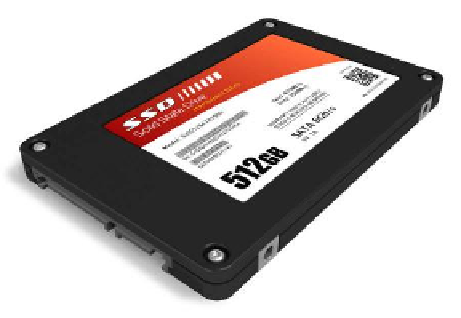Information Technology Reference
In-Depth Information
Optical discs are sturdy, but scratches, dirt, and fingerprints can prevent them from being read accurately.
Store discs in a protective sleeve or case when you are not using them, and hold discs only by their edges.
Don't let anything touch the shiny side of the disc, especially anything sharp or abrasive. If you need to write
on a disc, write only on the label side, and use only a suitable soft marking pen.
CAUTION
Solid-State Drives
A solid-state drive (SSD) uses a type of EEPROM to store data in tiny
transistors. As you learned in
Chapter 2,
electrically erasable program-
mable read-only memory (EEPROM) is a type of memory that stores its
contents permanently; it is nonvolatile. Because it is electrically erasable,
the computer can erase what's written there and rewrite it. The type of
EEPROM used in solid-state drives can be erased and rewritten in small
blocks, making it suitable for use as a storage device.
When a solid-state drive is a large-capacity replacement for an HDD, it's
sometimes called a
solid-state hard drive (SSHD)
to distinguish it from
lower-capacity portable solid-state storage, such as USB flash drives.
Figure 3.30 shows a solid-state hard drive.
solid-state hard drive (SSHD)
A high- capacity
solid-state storage device that substitutes for an
HDD as the main storage drive in a computer.
© iStockphoto.com/scanrail
Figure.3 30
A solid-state hard drive looks much like an HDD
from the outside.
Solid-state drives are silent because they don't have any moving parts,
and the access time is very fast because there are no read/write heads
that have to move anywhere to get to the data. SSDs are more expensive
than HDDs, though; you get much less capacity for the money. For this
reason, SSHDs are found mostly in high-end desktop and notebook
computers. Solid-state storage is common in tablets and smartphones,
where high-capacity storage is not needed and being lightweight is a
primary concern.
To balance between performance and cost, some systems have both a
small SSD and a larger HDD. The SSD contains the start-up files and the
operating system, and the HDD holds everything else. Hybrid drives are
also available that combine the two technologies in a single physical unit.





